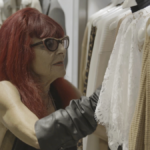
There is a reason for the Carlos Santana documentary, “Carlos,” to take its title not from the guitar legend’s last name and that of his eponymous band. The film, which received a gala world premiere at the Tribeca Film Festival, focuses more on Santana’s biographical details recounted previously in his 2014 memoir, “The Universal Tone,” than his illustrious career. Of course, music is inseparable from the life of a Rock & Roll Hall of Famer born into a musical family, but the documentary is more about wrestling with success, spirituality, addiction and childhood trauma from sexual abuse.
Filmmaker Rudy Valdez unfurls a chronological narrative, from Santana’s formative years in Tijuana, Mexico, to his triumphant 1999 “Supernatural” album, employing archives of photos, concert footage, talk-show appearances, home videos and a few newly conducted interviews, including a roundtable of Santana’s immediate family members. But amid the narrative progression Valdez has occasionally spliced in materials from earlier time periods as flashbacks, a poignant representation of memories that have haunted the guitarist throughout his 75 years.
Santana’s parents cast a long shadow over him. His father, José, played violin in a mariachi band. Young Carlos naturally learned to play the fiddle. Once exposed to guitar, though, he was immediately taken. He went down the rabbit hole from there, discovering B.B. King, Little Richard and the like, and completely shifting his taste. He crossed the U.S. border and while standing outside a musical instrument store admiring his new object of fascination, he also experienced his first brush with racism.
His father later found steady work in San Francisco, where Santana continued to chart his own path in music. The earliest known recording of him, dated 1966, shows the then-19-year-old in rehearsal. Over his parents’ objections, he soon became immersed in the music scene centered on The Fillmore, even as his high-school peers turned to more conventional career paths and his family needed money. Outside The Fillmore trying to sneak a peek, he caught the attention of promoter Bill Graham, who soon began booking the Santana Blues Band as an opening act for The Who and Steve Miller, among others, and as a go-to for filling in cancellations.
As their reputation soared in San Francisco, Santana and his band fielded interest from labels. He purposely blew an audition with Atlantic Records due to his desire to work with Columbia’s Clive Davis, who presided over the front row at Saturday’s premiere. Davis now serves as chief creative officer of Sony Music Entertainment, the production outfit behind this documentary. Santana attributed his success to the impresario, both in the film and during the rousing hourlong post-screening live set at the Beacon Theatre. Interestingly, the “Milli Vanilli” documentary, produced by third-party MTV, which also premiered at Tribeca, presents Davis in a vastly different light.
Graham began booking Santana and his band at increasingly sizable music festivals around the country, culminating in a set at the storied Woodstock in 1969 a couple of weeks before the release of Santana’s debut album. He gave his first royalty check to his mother toward the purchase of a new home and a refrigerator. He said the ability to fulfill a promise to her was better than the accolades he amassed throughout his career.
The band played 312 concerts in one year, which, along with the sex and drugs, caused irreconcilable fissures. There have been 23 iterations of Santana, the band. Valdez illustrates this with the same verse sung by three different singers on separate occasions. Between 1972 and 1982, the guitarist followed guru Sri Chinmoy and experienced a spiritual awakening, cutting his hair and dressing all in white. This influenced his musical direction as well, alienating some bandmates.
Throughout the documentary, Santana credits many musical influences, but he has gone through significant stylistic paradigm shifts. In the absence of critics and historians providing commentary and appraisal, “Carlos” glosses over items of significant public interest. Snippets of Santana jamming inside his home studio seem marginally interesting, but also extremely niche beside iconic public performances such as the 1982 Concert of the Americas set amid a storm.
Nevertheless, there are profound and powerful anecdotes, such as Santana describing taking a shower and visualizing the shame associated with being a sexual abuse survivor going down the drain, that elevate “Carlos” from the garden-variety music biographical puff pieces produced by record labels and/or available on various streaming platforms.















